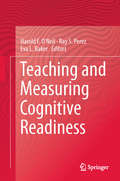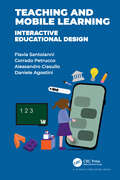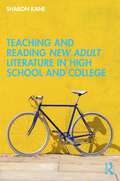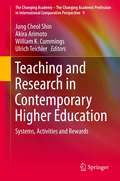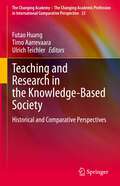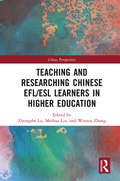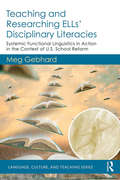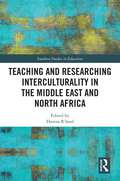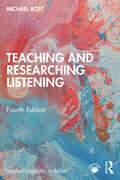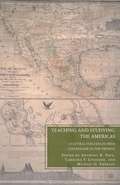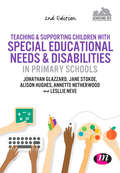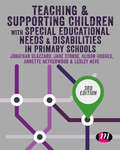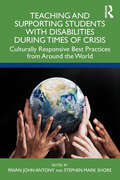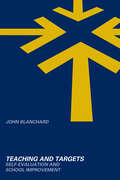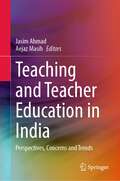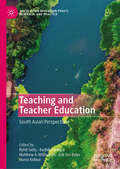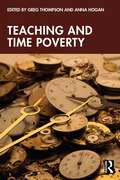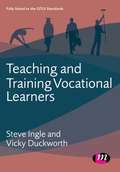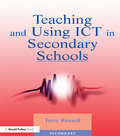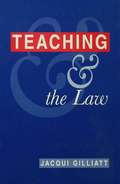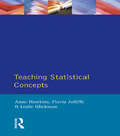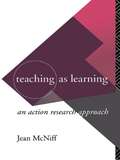- Table View
- List View
Teaching and Measuring Cognitive Readiness
by Eva L Baker Ray S. Perez Harold F. O'NeilTeaching and Measuring Cognitive Readiness presents theoretical and empirical findings regarding cognitive readiness and assessments of their impact on adult learning. The term readiness is used in assessing student preparation for K-12 schools, while in the military and in industry, "readiness" denotes preparation to be effective in performing a mission or a job. Cognitive Readiness is viewed through a Knowledge, Skills, and Attributes (KSA) lens. Teaching and Measuring Cognitive Readiness deals with (a) the primacy of cognitive readiness as attributes or individual difference variables; (b) the need for cognitive readiness instructional and assessment strategies; (c) the need to integrate assessment into cognitive readiness training; (d) the need for theory-driven evaluation studies to increase knowledge and efficacy in teaching cognitive readiness; and (e) the need for a solid psychometric approach to the use of cognitive readiness assessments.
Teaching and Mobile Learning: Interactive Educational Design
by Flavia Santoianni Corrado Petrucco Alessandro Ciasullo Daniele AgostiniTeaching and Mobile Learning: Interactive Educational Design is a groundbreaking book which shows how to design innovative educational mobile learning environments to instructional designers, curriculum developers, and learning professionals. The book aims to solicit teachers, educators, and practitioners to adapt their teaching with the help of educational digital models related to mobile technologies. Mobile learning is a revolution in concepts like space, sound production, and learning to get more and more customized in always-connected and ever-changing educational mobile learning environments. Researchers and academicians can be trained in cognition processes in learning management of mixed reality and virtual bodies. Mixed reality mobile technologies are becoming tools for education and training in mixed reality mobile learning. Readers of this book will understand how user and device innovative interactions are borderline with attention deficit disorder, digital amnesia, and information overload. The book develops educational knowledge on how to manage mobile technology and specific learning disorders to monitor the use of smartphones and technology tools and to empower their role in learning enhancement processes.
Teaching and Reading New Adult Literature in High School and College
by Sharon KaneAn introduction to the rapidly growing category of New Adult (NA) literature, this text provides a roadmap to understanding and introducing NA books to young people in high school, college, libraries, and other settings. As a window into the experiences and unique challenges that young and new adults encounter, New Adult literature intersects with but is distinct from Young Adult literature. This rich resource provides a framework, methods, and plentiful reading recommendations by genre, theme, and discipline on New Adult literature. Starting with a definition of New Adult literature, Kane demonstrates how the inclusion of NA literature helps support and encourage a love of reading. Chapters address important topics that are relevant to young people, including post-high school life, early careers, relationships, activism, and social change. Each chapter features text sets, instructional strategies, writing prompts, and activities to invite and encourage young people to be reflective and engaged in responding to thought-provoking texts. A welcome text for professors of literacy and literature instruction, first-year college instructors, researchers, librarians, and educators, this book provides new ways to assist students as they embark upon the next stage of their lives and is essential reading for courses on teaching literature.
Teaching and Research in Contemporary Higher Education: Systems, Activities and Rewards
by William K. Cummings Ulrich Teichler Jung Cheol Shin Akira ArimotoThis book discusses how teaching and research have been weighted differently in academia in 18 countries and one region, Hong Kong SAR, based on an international comparative study entitled the Changing Academic Profession (CAP). It addresses these issues using empirical evidence, the CAP data. Specifically, the focus is on how teaching and research are defined in each higher education system, how teaching and research are preferred and conducted by academics, and how academics are rewarded by their institution. Since the establishment of Berlin University in 1810, there has been controversy on teaching and research as the primary functions of universities and academics. The controversy increased when Johns Hopkins University was established in 1876 with only graduate programs, and more recently with the release of the Carnegie Foundation report Scholarship Reconsidered by Ernest L. Boyer in 1990. Since the publication of Scholarship Reconsidered in 1990, higher education scholars and policymakers began to pay attention to the details of teaching and research activities, a kind of 'black box' because only individual academics know how they conduct teaching and research in their own contexts.
Teaching and Research in the Knowledge-Based Society: Historical and Comparative Perspectives (The Changing Academy – The Changing Academic Profession in International Comparative Perspective #23)
by Ulrich Teichler Timo Aarrevaara Futao HuangThis book addresses common themes relating to the teaching and research nexus in the knowledge-based society through historical, comparative and empirical perspectives. It analyzes traditions of academic systems and national initiatives, and other factors affecting the main characteristics of the teaching and research nexus in eleven case countries from Asia, Europe, North America and South America. The book identifies key challenges of the academy, and trends in relation to the teaching and research nexus. The focus of case countries is on the attitudes and activities of the academy, as reported in the international comparative survey “The Academic Profession in the Knowledge-Based Society” (APIKS) in 2017-18. The data compared with previous international comparative survey “The Changing Academic Profession” (CAP) in 2007-08 in most chapters to make time series changes. The book discusses the teaching and research nexus in the case countries similar to and different from those of reference countries drawing on findings from the international databanks of the two international comparative surveys and previous research.
Teaching and Researching Chinese EFL/ESL Learners in Higher Education (China Perspectives)
by Zhongshe LuChina has attached great importance to teaching students to become proficient users of English. Yet, despite a plethora of studies and practice on Chinese ESL/EFL (English as a second/foreign language) learners, the large student population, its complicated composition and the complex nature of second and foreign language learning have rendered it difficult to offer a panoramic view on ESL/EFL teaching and learning of Chinese learners. This book provides a new and up-to-date perspective on the teaching and learning of Chinese ESL/EFL learners. The book collects 15 case studies, falling into two parts—Curriculum Development and Teaching Practice and Skills-Based Research. The collected studies deploy qualitative, quantitative or mixed methods to explore patterns, features, developments and causes and effects of a variety of issues in the sphere of ESL/EFL teaching and learning. Moreover, the cases offer insights that are relevant beyond the mainland Chinese context such as Hong Kong, Macau, Britain and Australia. Students and scholars of TESOL and applied linguistics will be interested in this title.
Teaching and Researching ELLs’ Disciplinary Literacies: Systemic Functional Linguistics in Action in the Context of U.S. School Reform (Language, Culture, and Teaching Series)
by Meg GebhardWritten from a critical perspective, this volume provides teachers, teacher educators, and classroom researchers with a conceptual framework and practical methods for teaching and researching the disciplinary literacy development of English language learners (ELLs). Grounded in a nuanced critique of current social, economic, and political changes shaping public education, Gebhard offers a comprehensive framework for designing curriculum, instruction, and assessments that build on students’ linguistic and cultural resources and that are aligned with high-stakes state and national standards using the tools of systemic functional linguistics (SFL). By providing concrete examples of how teachers have used SFL in their work with students in urban schools, this book provides pre-service and in-service teachers, as well as literacy researchers and policy makers, with new insights into how they can support the disciplinary literacy development of ELLs and the professional practices of their teachers in the context of current school reforms. Key features of this book include the voices of teachers, examples of curriculum, sample analyses of student writing, and guiding questions to support readers in conducting action-oriented research in the schools where they work.
Teaching and Researching Interculturality in the Middle East and North Africa (Southern Studies in Education)
by R’boul HamzaFocusing on the emerging intercultural encounters in the Middle East and North Africa (MENA), this book brings together diverse perspectives from the region to explore understandings and practices of interculturality in different educational environments.Teaching and researching interculturality has received increasing attention from scholars and educators alike in the Middle East and North Africa (MENA) region due to intensified cross-cultural interactions resulting from recent economic and political changes. In the face of these challenges and complexities, this edited volume aims to (a) develop an in-depth understanding of how interculturality is processed and taught in different educational settings (middle school, high school, and university) by different actors (students, teachers and curriculum designers, policy makers, etc.) and (b) construct context-sensitive, critical, and nuanced perspectives, theories, and practices for teaching and researching interculturality. While 'interculturality' is an overarching notion in this book, the chapters use different 'labels' to refer to interculturality in education, communication, and research, with a particular focus on sociologies of knowledge in seven countries.This title is essential read for educators, researchers, and policy makers interested in the intersection of language and sociology, as well as intercultural education and communication in the region.
Teaching and Researching Listening: Third Edition (Applied Linguistics in Action)
by Michael RostWidely considered to be a foundational work in the field of listening, Teaching and Researching Listening is among the most recommended textbooks in applied linguistics oral communication courses, and the most cited reference in current research on second language listening development. Known for its comprehensiveness, clarity, insight, and practical applications, this fourth edition has been substantially revised to reflect the latest research in the areas of linguistics, neuroscience, applied technologies, and teaching methodology, with expanded sections on teaching applications and explorations in social research related to listening.This completely revised edition includes:• Detailed overviews of the underlying processes of listening, with additional coverage of decoding processes• Expansion of sections dealing with artificial intelligence (AI), speech recognition, and input enhancement software• Emphasis on research of listening in spoken interaction and cross-cultural communication • Clear templates for instructors and curriculum designers, with an expansive set of practical resources• Guidance in using observational methods for exploring listening in a range of educational and professional contexts• Website support, with presentation slides, infographics, and question banks for each chapterThis fourth edition of Teaching and Researching Listening serves as an authoritative and comprehensive survey of issues related to teaching and researching oral communication, providing value for language teachers, educational researchers, instructional designers, interpreters, and other language practitioners.
Teaching and Studying the Americas
by Caroline F. Levander Anthony B. Pinn Michael O. EmersonThis book considers how interdisciplinary conversation, critique, and collaboration enrich and transform humanities and social science education for those teaching and studying traditional Americanist fields.
Teaching and Supporting Adult Learners (Further Education)
by Jackie Scruton Belinda FergusonAn accessible and up to date text on teaching and supporting adult learners, aimed at both student teachers and experienced practitioners. It explores teaching adult learners within a traditional further education (FE) context but also working with those adult learners on Higher Education (HE) courses taught within FE.Adult learners have a distinct set of needs and challenges which can include issues of self confidence, fear of technology, time management and financial constraints, and which may not always be fully recognised by educational practitioners or institutions. Teachers and student stories are used throughout this book to analyse learner needs and motivations, highlight possible barriers to learning and explore strategies for support.This publication enables those teaching adult learners to gain an understanding of the difficulties that students may experience while developing their own professional practice in order to create effective, focused and inclusive teaching strategies for this group.
Teaching and Supporting Children with Special Educational Needs and Disabilities in Primary Schools (Achieving QTS Series)
by Jonathan Glazzard Alison Hughes Annette Netherwood Lesley Neve Jane StokoeIf you are a primary trainee, or are training to support children in primary schools, this is your guide to working with children with Special Educational Needs and Disabilities (SEND). We begin by exploring what is meant by SEND in primary schools and go on to cover all you need to know about your statutory responsibilities in school. Current legislation and the Code of Conduct are covered, to give you lots of information about the content you will be working in. The book then examines the range of needs you will encounter in primary schools giving you details information and practical advice. This second edition has been fully restructured and updated to include a new section on the key theory relating to SEND. Exploring theories and theorist that you will need to know about to fully understand how to support children. Also new for this edition is a chapter focusing on the role of the SENCO in the primary school. Finally, the book includes more practical support to help you in the classroom. Checklists to help you to work comprehensively and information about useful resources and outside agencies.
Teaching and Supporting Children with Special Educational Needs and Disabilities in Primary Schools (Achieving QTS Series)
by Jonathan Glazzard Alison Hughes Annette Netherwood Lesley Neve Jane StokoeIf you are a primary trainee, or are training to support children in primary schools, this is your guide to working with children with Special Educational Needs and Disabilities (SEND). We begin by exploring what is meant by SEND in primary schools and go on to cover all you need to know about your statutory responsibilities in school. Current legislation and the Code of Conduct are covered, to give you lots of information about the content you will be working in. The book then examines the range of needs you will encounter in primary schools giving you details information and practical advice. This second edition has been fully restructured and updated to include a new section on the key theory relating to SEND. Exploring theories and theorist that you will need to know about to fully understand how to support children. Also new for this edition is a chapter focusing on the role of the SENCO in the primary school. Finally, the book includes more practical support to help you in the classroom. Checklists to help you to work comprehensively and information about useful resources and outside agencies.
Teaching and Supporting Children with Special Educational Needs and Disabilities in Primary Schools (Achieving QTS Series)
by Jonathan Glazzard Alison Hughes Annette Netherwood Lesley Neve Jane StokoeThis book begins by exploring what is meant by SEND in primary schools and goes on to cover everything trainees and teachers need to know about their statutory responsibilities in school. It then examines the range of needs they will encounter in primary schools with plenty of practical advice along the way. This third edition has been fully restructured and updated to include a new section on the key theories and theorists relating to SEND. Also new to this edition is a chapter focusing on the role of the SENCO in primary school. Finally, the book includes more practical support with coverage of current legislation and the Code of Conduct as well as checklists and information about useful resources and outside agencies.
Teaching and Supporting Children with Special Educational Needs and Disabilities in Primary Schools (Achieving QTS Series)
by Jonathan Glazzard Alison Hughes Annette Netherwood Lesley Neve Jane StokoeThis book begins by exploring what is meant by SEND in primary schools and goes on to cover everything trainees and teachers need to know about their statutory responsibilities in school. It then examines the range of needs they will encounter in primary schools with plenty of practical advice along the way. This third edition has been fully restructured and updated to include a new section on the key theories and theorists relating to SEND. Also new to this edition is a chapter focusing on the role of the SENCO in primary school. Finally, the book includes more practical support with coverage of current legislation and the Code of Conduct as well as checklists and information about useful resources and outside agencies.
Teaching and Supporting Students with Disabilities During Times of Crisis: Culturally Responsive Best Practices from Around the World
by Pavan John Antony Stephen Mark ShoreThis volume offers international perspectives on the disproportionate impact COVID-19 has had on disabled students and their families, serving as a call to action for educational systems and education policy to become proactive, rather than reactive, for future disasters. Each chapter in the book is written by authors with lived experiences across diverse global regions, highlighting the daily life of people with disabilities and their families during the pandemic. Including case studies and practical suggestions, the book demonstrates that culturally responsive practices are essential to successfully support people around the world in their times of need. At the critical intersection of education and disability human rights, this book is important for pre-service teachers, researchers, professors, and graduate students to ensure all students are supported during times of crisis.
Teaching and Targets: Self Evaluation and School Improvement
by John BlanchardTeachers, school managers and governors are now more publicly accountable than ever. They are expected to know how their school is performing and how to improve that performance. Target setting is a key tool in the drive to raise standards, and has been implemented at every level of the education system. This book explores target setting from both the teacher's and pupil's viewpoint, and investigates the role of assessment in successful teaching and learning. It shows that it is possible to develop a whole-school target setting policy co-ordinating the use of targets for individual pupils, subject specific departments and teams, and whole-school improvement plans. In this way, targets can be used positively for the benefit of pupils, teachers and managers. This book will be important reading for headteachers, senior management teams, assessment co-ordinators and subject leaders in schools, and will also be of interest to governors and LEA advisors.
Teaching and Teacher Education in India: Perspectives, Concerns and Trends
by Jasim Ahmad Aejaz MasihThis book provides a focused and comprehensive overview of gradual development and reforms in teacher education in India. It discusses historical development, policy perspectives, quality concerns, current practices, and trends of teacher education in India. It highlights the prevailing social image of teachers and the teaching profession, as well as the emerging problems and issues faced in teacher development programs, indicating the need to focus upon the transformative changes. Each chapter provides an in-depth research-based analysis and reflects on a specific theme: education policies and commissions, curricular reforms, ICT integration, and the digital revolution. It offers alternative practices by drawing a comparison with developed nations. It is an indispensable resource for teacher educators, school administrators, curriculum designers, policymakers, and researchers in teacher education.
Teaching and Teacher Education: South Asian Perspectives (South Asian Education Policy, Research, and Practice)
by Huma Kidwai Radhika Iyengar Matthew A. Witenstein Erik Jon Byker Rohit SettyThis edited volume brings together diverse thinkers and practitioners from the field of teaching and teacher education as it pertains to educational development in South Asia. In this volume, authors draw from their research, practice, and field experiences, showcasing how teaching and teacher education are currently being carried out, understood, theorized, debated, and implemented for the education of children and teachers alike in South Asia. The volume also includes practitioner voices, which are often marginalized in academic discourse. This book acts as a key reference text for academics and practitioners interested in the intersection of education and development in the region, and in particular what it takes to pull off ambitious teaching and teacher education in South Asia.
Teaching and Time Poverty: Understanding Workload and Work Intensification in Schools
by Greg Thompson Anna HoganAs teacher shortages reach a global crisis point, this book explores how time poverty has become a critical factor in the working lives of teachers and school leaders. Arguing that we need to move away from framing the problem of teachers’ work as simply workload, this book suggests that understanding time poverty is the first step in moving toward more manageable working lives.The book brings together international perspectives on teacher time poverty, drawing on theoretical and empirical work to underscore the growing complexity of teachers’ work and how this impacts job satisfaction, stress and feeling that there is never enough time to accomplish all that needs to be done. Many policy solutions misdiagnose the problems of teachers’ work, simply suggesting it is an issue of workload. The chapters investigate issues of work intensification, finding that teachers are not only working longer, but also working harder as they manage more complex classrooms and policy mandates. This book is essential reading for those interested in understanding how current education policy both produces time poverty and could better identify and respond to the complexities of teachers’ work.
Teaching and Training Vocational Learners (Further Education and Skills)
by Vicky Duckworth Steve IngleIf you are teaching or training to teach vocational learners across the further education and skills sector or in the workplace, this is your essential guide. Teaching and Training Vocational Learners is a focused text written to support those who are working with vocational learners, taking into account the specific needs of this group. It provides practical advice and guidance to help you to shape your approach to teaching, learning and assessment. It has comprehensive coverage of the learning you need to prepare you to teach. Throughout, the authors offer a range of exciting and practical examples to help you to expand your 'vocational teaching toolkit'. Included are lesson plans, assessment grids, assignment briefs, ideas to engage employers, help on marking vocational evidence, planning trips and visits and much more.
Teaching and Using ICT in Secondary Schools
by Terry RussellThe coverage of this book will provide an ideal text for use during departmental meetings for all curriculum subjects where ICT is an issue. It can also be used as a reference text for school based mentors taking part in the teacher training process. As well as discussing the effective teaching of ICT as a curriculum subject, the author uses sample case studies to illustrate the wider role at Key Stages 3 and 4, for GCSE and for post-16 in the form of VCE. He also advises on the teacher training process; the primary/secondary transfer; issues related to interface design; hardware and software provision; and the assessment, recording and reporting of ICT capability.This book will appeal to a wide range of target readerships: trainees taking PGCE courses to become specialist ICT teachers as well as other PGCE trainees, as they all have to meet statutory ICT standards; practicing secondary teachers, whether specialists in ICT or other subjects, who need to use ICT in their teaching; and secondary mentors with ICT as a major part of their responsibility.
Teaching and the Law
by Gilliatt, JacquiThe increased accountability of teachers has meant that actions on negligence are a reality. This is a comprehensive guide to all aspects of the law for teachers, covering everything from the employment relationship to lesson content and discipline.
Teaching as Communication (Effective Teacher, The)
by Bob HodgeGood teaching relies on a firm grasp of the communication process. In this innovative text Bob Hodge presents common pitfalls in the communication of teachers, and shows where they are most likely to mistake the communication of pupils. He uses practical examples which enable the reader to see an immediate and direct connection with classroom practises, making principles easier to understand and apply.
Teaching as Learning: An Action Research Approach
by Jean McNiffIn this fascinating and very personal book, Jean McNiff, author of the successful Action Research: Principles and Practice, argues that educational knowledge is created by individual teachers as they attempt to express their own values in their professional lives. Working with case studies of actual practice, she looks again at the familiar action research paradigm of identifying a problem, imagining, implementing and evaluating a solution and modifying practice in the light of that evaluation. She gives practical advice on how working in this way can aid the professional development of action researcher and practitioner alike. She concludes that the best teaching is done by those who want to learn and who can show others how to be open to their own processes of self development.
